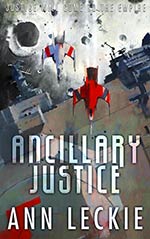
![]() spectru
spectru
4/19/2015
![]()
The basic concept of Ancillary Justice takes awhile to get accustomed to. In that regard it is similar to The City & The City by China Meiville. Not that its story is similar; it's not at all -- but that its concept is so unfamiliar, original, different, that it takes concentration to grasp it. It's not an easy read. The prose is dense; I sometimes found myself rereading a sentence or a paragraph or a page to get the meaning of it. In general I liked the story. Considering that this is Ann Leckie's debut novel, it's quite good.
For the first half of the book or so, the chapters alternate between the present story line and a parallel story nineteen years earlier, a story of political intrigue and treachery, that explains how the protagonist finds herself in her current situation. Then, the nineteen-years-ago time line ends and we continue with the present. There is a segment a bit after halfway through, where it drags; the story bogs down in the nuances of the etiquette of the culture, but it does finish as a strong page turner. It could be that the purpose of the alternating chapters in the first part of the book is to keep the story moving forward while we get familiar with the unusual political and cultural situation. The technical situation, having to do with AI and single mind - multiple bodies, and the cultural complexities are what make this book different, special, but it also makes it a little difficult. The story, when we aren't heavily involved with aristocracy and etiquette, can get quite intense.
Here is a little oddity: Our narrator, a non-human with an AI mind, frequently comments on the exact length of time a speaker pauses in conversation, 3 seconds, 6 seconds. I just found it curious. And she frequently describes her control of her facial expressions. Perhaps it is to convey her Commander Data-like personality.
Only the feminine pronouns she and her are used by the protagonist and those speaking in the Radch language. In the protagonist's culture, gender is ambiguous. When dealing people from other cultures, she had difficulty determining their gender and worried about making a gender faux pas. This is, I suppose, an innovative treatment of gender, but it seemed odd sometimes when the protagonist had been referring to a character as her and someone from a different culture would refer to that same character as him. Regardless of this, I pictured many of the main characters, including the protagonist, as male, and others as female. Frankly I found this quirk of the novel to be just slightly annoying, and I think I would have preferred the conventional treatment of gender.